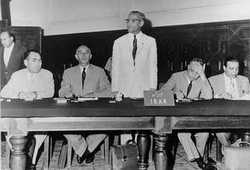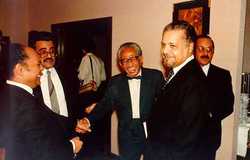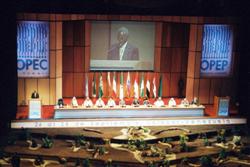20/02/13
 |
| 1st OPEC Conference, Baghdad, September 10–14, 1960 [SOURCE: http://www.opec.org] |
The Organization of the Petroleum Exporting
Countries (OPEC) is a permanent, intergovernmental Organization, created
at the Baghdad Conference on September 10–14, 1960, by Iran, Iraq,
Kuwait, Saudi Arabia and Venezuela. The five Founding Members were later
joined by nine other Members:
Qatar (1961); Indonesia (1962) –
suspended its membership from January 2009; Libya (1962); United Arab
Emirates (1967); Algeria (1969); Nigeria (1971); Ecuador (1973) –
suspended its membership from December 1992-October 2007; Angola (2007)
and Gabon (1975–1994). OPEC had its headquarters in Geneva, Switzerland,
in the first five years of its existence. This was moved to Vienna,
Austria, on September 1, 1965.
OPEC's objective is to co-ordinate and unify petroleum policies
among Member Countries, in order to secure fair and stable prices for
petroleum producers; an efficient, economic and regular supply of
petroleum to consuming nations; and a fair return on capital to those
investing in the industry.
The 1960s
OPEC’s formation by five oil-producing developing countries in
Baghdad in September 1960 occurred at a time of transition in the
international economic and political landscape, with extensive
decolonisation and the birth of many new independent states in the
developing world. The international oil market was dominated by the
“Seven Sisters” multinational companies and was largely separate from
that of the former Soviet Union (FSU) and other centrally planned
economies (CPEs). OPEC developed its collective vision, set up its
objectives and established its Secretariat, first in Geneva and then, in
1965, in Vienna. It adopted a ‘Declaratory Statement of Petroleum
Policy in Member Countries’ in 1968, which emphasised the inalienable
right of all countries to exercise permanent sovereignty over their
natural resources in the interest of their national development.
Membership grew to ten by 1969.
The 1970s
OPEC rose to international prominence during this decade, as its
Member Countries took control of their domestic petroleum industries and
acquired a major say in the pricing of crude oil on world markets. On
two occasions, oil prices rose steeply in a volatile market, triggered
by the Arab oil embargo in 1973 and the outbreak of the Iranian
Revolution in 1979. OPEC broadened its mandate with the first Summit of
Heads of State and Government in Algiers in 1975, which addressed the
plight of the poorer nations and called for a new era of cooperation in
international relations, in the interests of world economic development
and stability. This led to the establishment of the OPEC Fund for
International Development in 1976. Member Countries embarked on
ambitious socio-economic development schemes. Membership grew to 13 by
1975.
The 1980s
 |
| 73rd (Extraordinary) OPEC Conference, Geneva, January 28–30, 1985 |
After reaching record levels early in the decade, prices began to
weaken, before crashing in 1986, responding to a big oil glut and
consumer shift away from this hydrocarbon. OPEC’s share of the smaller
oil market fell heavily and its total petroleum revenue dropped below a
third of earlier peaks, causing severe economic hardship for many Member
Countries. Prices rallied in the final part of the decade, but to
around half the levels of the early part, and OPEC’s share of newly
growing world output began to recover. This was supported by OPEC
introducing a group production ceiling divided among Member Countries
and a Reference Basket for pricing, as well as significant progress with
OPEC/non-OPEC dialogue and cooperation, seen as essential for market
stability and reasonable prices. Environmental issues emerged on the
international energy agenda.
The 1990s
Prices moved less dramatically than in the 1970s and 1980s, and
timely OPEC action reduced the market impact of Middle East hostilities
in 1990–91. But excessive volatility and general price weakness
dominated the decade, and the South-East Asian economic downturn and
mild Northern Hemisphere winter of 1998–99 saw prices back at 1986
levels. However, a solid recovery followed in a more integrated oil
market, which was adjusting to the post-Soviet world, greater
regionalism, globalisation, the communications revolution and other
high-tech trends. Breakthroughs in producer-consumer dialogue matched
continued advances in OPEC/non-OPEC relations. As the United
Nations-sponsored climate change negotiations gathered momentum, after
the Earth Summit of 1992, OPEC sought fairness, balance and realism in
the treatment of oil supply. One country left OPEC, while another
suspended its Membership.
The 2000s
 |
| 2nd Heads of State Summit, 26-28 September 2000, Caracas, Venezuela |
An innovative OPEC oil price band mechanism helped strengthen and
stabilise crude prices in the early years of the decade. But a
combination of market forces, speculation and other factors transformed
the situation in 2004, pushing up prices and increasing volatility in a
well-supplied crude market. Oil was used increasingly as an asset class.
Prices soared to record levels in mid-2008, before collapsing in the
emerging global financial turmoil and economic recession. OPEC became
prominent in supporting the oil sector, as part of global efforts to
address the economic crisis. OPEC’s second and third summits in Caracas
and Riyadh in 2000 and 2007 established stable energy markets,
sustainable development and the environment as three guiding themes, and
it adopted a comprehensive long-term strategy in 2005. One country
joined OPEC, another reactivated its Membership and a third suspended
it.
SOURCE: http://www.opec.org

No comments:
Post a Comment